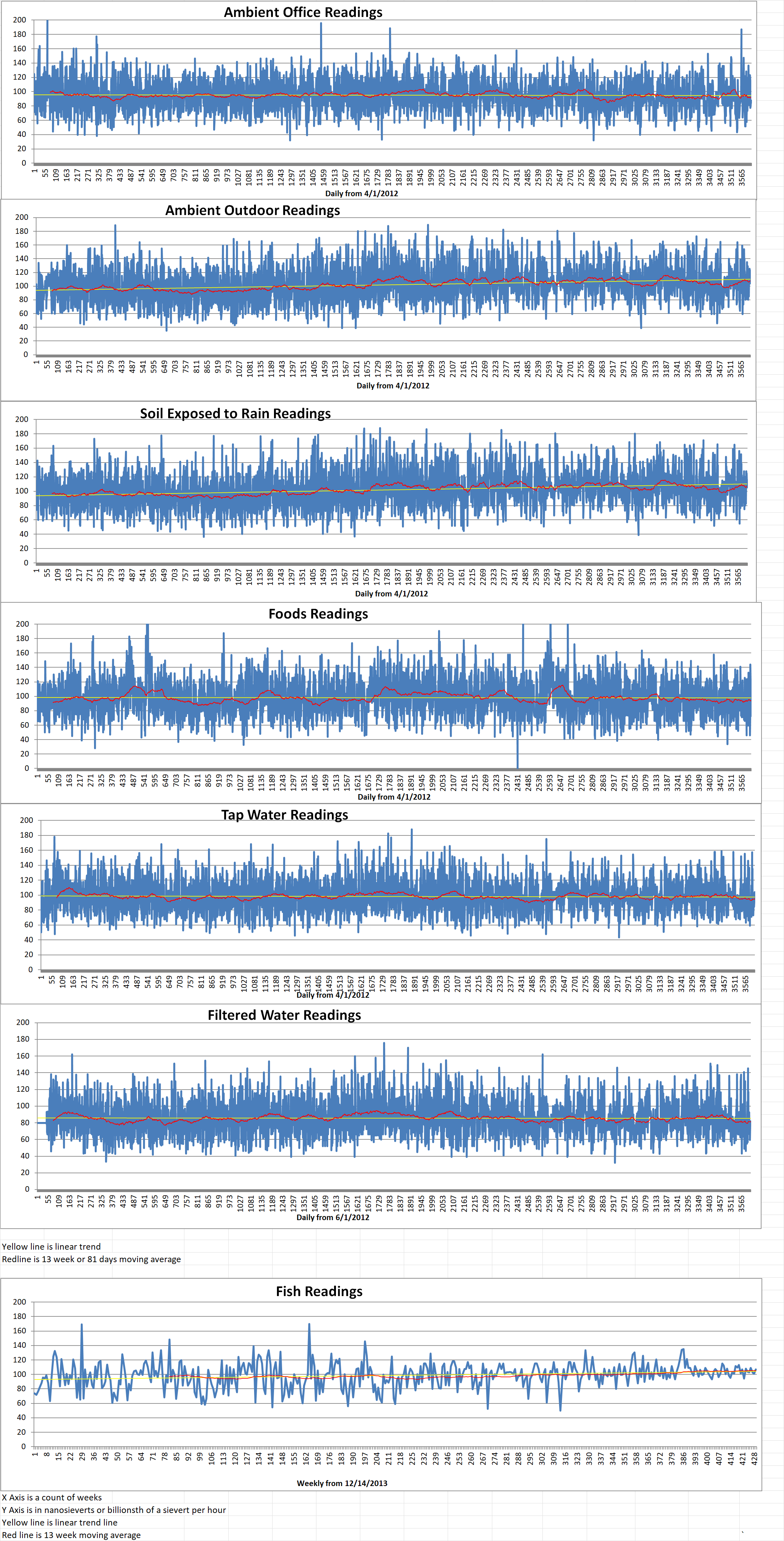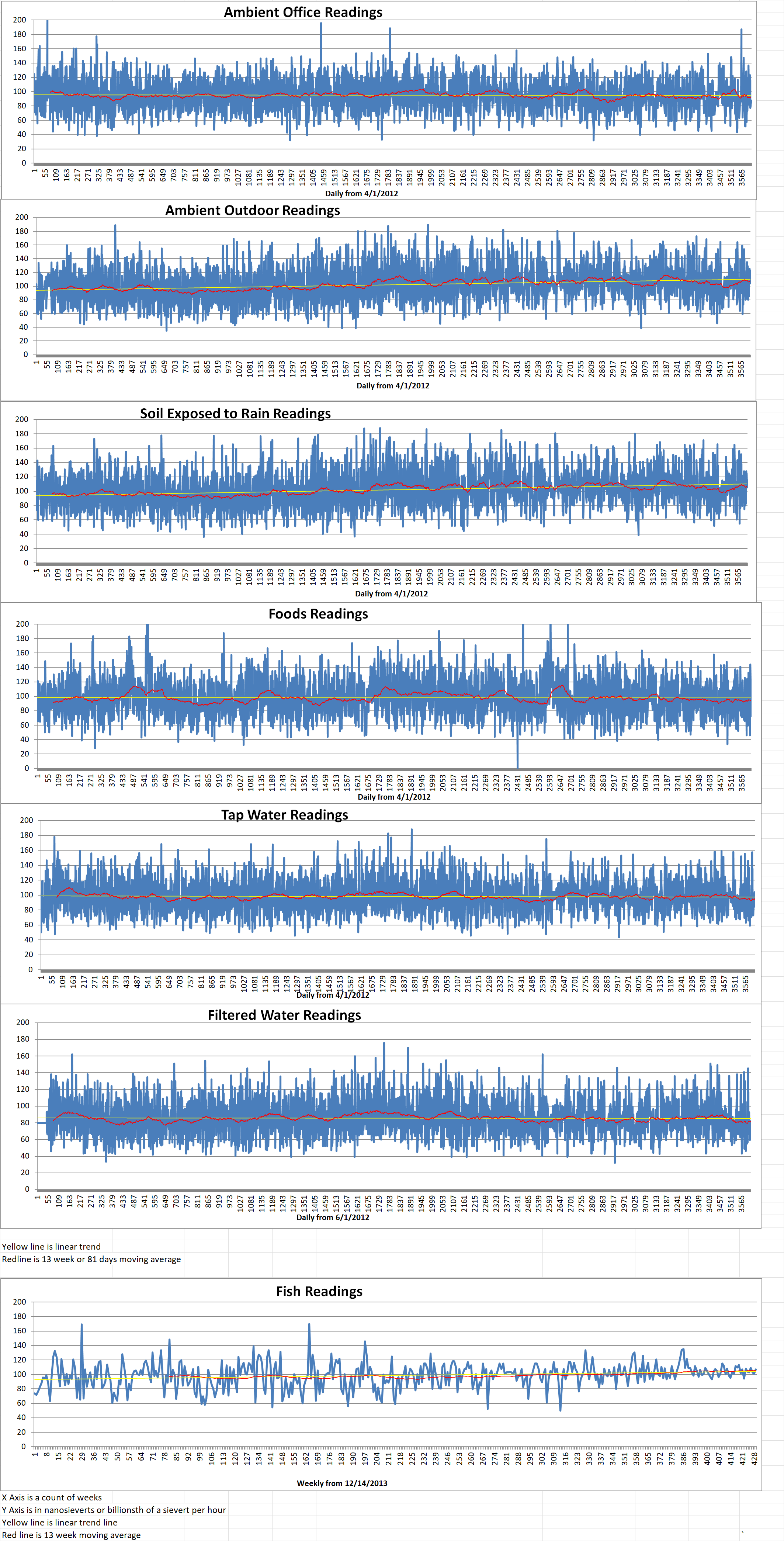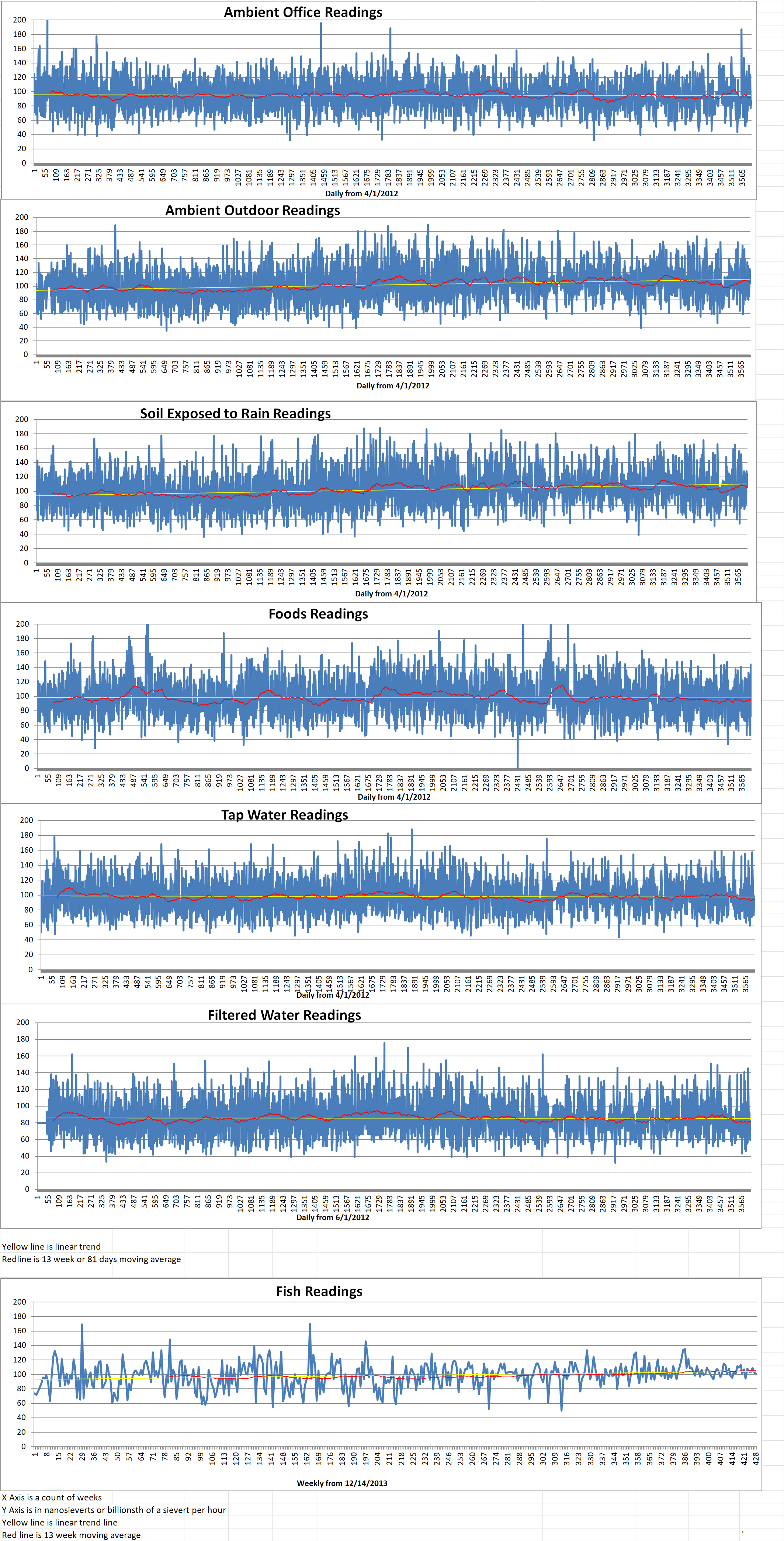Blog
-

Geiger Readings for May 22, 2022
Ambient office = 86 nanosieverts per hour
Ambient outside = 120 nanosieverts per hour
Soil exposed to rain water = 117 nanosieverts per hour
Baby Bella Mushroom from Central Market = 117 nanosieverts per hour
Tap water = 92 nanosieverts per hour
Filter water = 80 nanosieverts per hour
-
Nuclear News Roundup May 21, 2022
Construction of Xudapu 4 under way world-nuclear-news.org
Mullen says US should consider the possibility of Russia using a nuclear weapon thehill.com
No Iran nuclear deal ‘worse’ than even a bad one: Israel sources Aljazeera.com
South Korean APR-1400 starts up world-nuclear-news.org
-

Geiger Readings for May 21, 2022
Ambient office = 88 nanosieverts per hour
Ambient outside = 113 nanosieverts per hour
Soil exposed to rain water =116 nanosieverts per hour
Avocado from Central Market = 122 nanosieverts per hour
Tap water = 104 nanosieverts per hour
Filter water = 81 nanosieverts per hour
Dover sole = 107 nanosieverts per hour
-

Nuclear Fusion 178 – EPFL Has Revised A fundamental Principle For Fusion Research – Part 2 of 2 Parts
Part 2 of 2 Parts (Please read Part 1 first)
Ricci explained that “Greenwald derived the law empirically, that is completely from experimental data—not a tested theory, or what we’d call ‘first principles’. Still, the limit worked pretty well for research. And, in some cases, like DEMO (ITER’s successor), this equation constitutes a big limit to their operation because it says that you cannot increase fuel density above a certain level.”
Working with fellow tokamak teams at other institutions, the Swiss Plasma Center designed an experiment where it was possible to use highly sophisticated technology to precisely control the amount of fuel injected into a tokamak. Their experiments were carried out at the worlds largest tokamaks, the Joint European Torus (JET) in the UK, as well as the ASDEX Upgrade in Germany (Max Plank Institute) and EPFL’s own TCV tokamak. This broad experimental effort was made possible by the EUROfusion Consortium (EC). The EC is the European organization that coordinates fusion research in Europe. EPFL participates in the EC through the Max Planck Institute for Plasma Physics in Germany.
Maurizio Giacomin is a Ph.D. student on Ricci’s team. At the same time that the big international experiment was being run, he began to analyze the physical processes that limit the fuel density in tokamaks. His goal was to derive a first-principles law that can correlate fuel density and tokamak size. Part of his work involved using advanced simulations of the plasma carried out with a computer model.
Ricci said, “The simulations exploit some of the largest computers in the world, such as those made available by CSCS, the Swiss National Supercomputing Center and by EUROfusion. And what we found, through our simulations, was that as you add more fuel into the plasma, parts of it move from the outer cold layer of the tokamak, the boundary, back into its core, because the plasma becomes more turbulent. Then, unlike an electrical copper wire, which becomes more resistant when heated, plasmas become more resistant when they cool down. So, the more fuel you put into it at the same temperature, the more parts of it cool down—and the more difficult is for current to flow in the plasma, possibly leading to a disruption. Turbulence in a fluid is actually the most important open issue in classical physics. But turbulence in a plasma is even more complicated because you also have electromagnetic fields.”
Ricci and his team were able to develop the needed computer model and they derived a new equation for fuel limits in a tokamak which aligns very well with the experimental data. Their report was published in Physical Review Letters. Their work updates the classic principle of Greenwald.
The new equation developed by Ricci and his team proposed that the Greenwald limit can almost be doubled in terms of fuel in ITER. This means that tokamaks similar to ITER can actually use almost twice as much fuel to produce plasmas without worrying about disruptions. Ricci said, “This is important because it shows that the density that you can achieve in a tokamak increases with the power you need to run it. “Actually, DEMO will operate at a much higher power than present tokamaks and ITER, which means that you can add more fuel density without limiting the output, in contrast to the Greenwald law. And that is very good news.” -
Nuclear News Roundup May 20, 2022
Jacobs to support Fukushima Daiichi decommissioning world-nuclear-news.org
Trump warns of ‘greatest danger ever’ for nuclear war gazette.com
Nuclear included in EU’s repowering plan world-nuclear-news.org
What’s Next for California’s Last Nuclear Power Plant nytimes.com
-

Geiger Readings for May 20, 2022
Ambient office = 87 nanosieverts per hour
Ambient outside = 108 nanosieverts per hour
Soil exposed to rain water = 99 nanosieverts per hour
Tomato from Central Market = 87 nanosieverts per hour
Tap water = 93 nanosieverts per hour
Filter water = 80 nanosieverts per hour
-

Nuclear Fusion 177 – EPFL Has Revised A fundamental Priciple For Fusion Reseaerch – Part 1 of 2 Parts
Part 1 of 2 Parts
École Polytechnique Fédérale de Lausanne (EPFL) is a Swiss public research university. Operating in a large European collaboration, EPFL has managed to revise one of the fundamental laws that have been foundational to plasma and fusion research for over three decades. Their work has even been used in the design of megaprojects such as the huge ITER fusion reactor being constructed in France.
Fusion is considered by many to be the most promising source of future energy. It involves combining two light atomic nuclei into one heavier nucleus. Huge amounts of energy are released in the process.
ITER is an international fusion research megaproject. It is aimed at replicating the fusion processes of the sun to create energy on Earth. In order to accomplish that, it must produce the extreme temperatures and pressures necessary for fusion to occur.
A plasma is an ionized state of matter similar to a gas. It is made up of positively charged nuclei and negatively charged electrons. The plasmas used in fusion research are about a million times less dense than the air we breathe. Plasmas are created by subjecting the fusion fuel, usually isotopes of hydrogen, to extremely high temperatures that are ten times the temperature of the core of the sun. This forces the electrons to separate from their atomic nuclei. One of the most popular experimental fusion designs is called a tokamak. It is a donut-shaped chamber surrounded by magnets.
Paolo Ricci works at the Swiss Plasma Center, one of the leading research institutions in fusion located at EPLF. He said, “In order to create plasma for fusion, you have to consider three things: high temperature, high density of hydrogen fuel, and good confinement.” Working within a large European collaboration, Ricci’s team has just released a new study. Their work updates a foundational principle of plasma generation. They have shown that the ITER tokamak can actually operate with twice the amount of hydrogen fuel normally used. This means that it can generate more fusion energy that was previously assumed.
Ricci said, “One of the limitations in making plasma inside a tokamak is the amount of hydrogen fuel you can inject into it. Since the early days of fusion, we’ve known that if you try to increase the fuel density, at some point there would be what we call a ‘disruption’—basically you totally lose the confinement, and plasma goes wherever. So in the eighties, people were trying to come up with some kind of law that could predict the maximum density of hydrogen that you can put inside a tokamak.”
In 1988, fusion scientist Martin Greenwald published a famous law that correlates fuel density to the minor radius of the tokamak and the electric current that flows in the plasma inside the tokamak. (Minor radius refers to the radius of the inner circle of the donut-shaped tokamak.) Ever since Greenwald stated his law, the “Greenwald limit” has been a foundational principle of fusion research. ITER’s tokamak-building strategy is based on it.
Please read Part 2 next -
Nuclear News Roundup May 19, 2022
Jacobs to support Fukushima Daiichi decommissioning world-nuclear-news.org
Trump warns of ‘greatest danger ever’ for nuclear war gazette.com
Nuclear included in EU’s repowering plan world-nuclear-news.org
What’s Next for California’s Last Nuclear Power Plant nytimes.com
-

Geiger Readings for May 19, 2022
Ambient office = 86 nanosieverts per hour
Ambient outside = 104 nanosieverts per hour
Soil exposed to rain water = 105 nanosieverts per hour
Red onion from Central Market = 72 nanosieverts per hour
Tap water = 98 nanosieverts per hour
Filter water = 82 nanosieverts per hour
